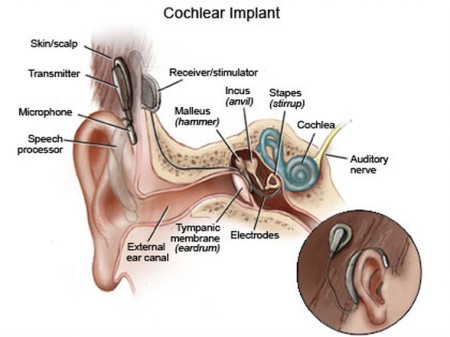A cochlear implant is an electronic device that is designed for use by severely or profoundly deaf children and adults who get little or no benefit from hearing aids.
The cochlear implant works by directly stimulating the nerves of the inner ear with electrical signals. These signals are interpreted by the brain and recognised as ‘sound’. There are two main parts to the cochlear implant – the internal and the external components.

The external parts consist of a microphone, a speech processor and a transmitter coil held in place behind the ear with a magnet. The microphone picks up the sound from around the user. The signal is then passed to the speech processor and converted into electrical signals. Each speech processor is individually tuned to each wearer’s needs. The electrical signals are sent via radio waves across the skin from the transmitter coil to the internal receiver. The microphone and processor can be positioned either behind the ear (in a device that looks very much like a hearing aid) or in a small box that can be worn on the body.
The internal parts are surgically implanted and include a receiver with a magnet that is positioned under the skin behind the ear, and a line of electrodes that is surgically inserted into the cochlea. The magnet holds the external transmitter coil directly over the implanted receiver.
The receiver picks up the signal from the transmitter coil and sends it to the electrodes.The electrodes directly stimulate the damaged hair cells of the cochlea, which sends the electrical signals along the nerve to the brain.
This video shows the electrode array being inserted into the cochlea.



